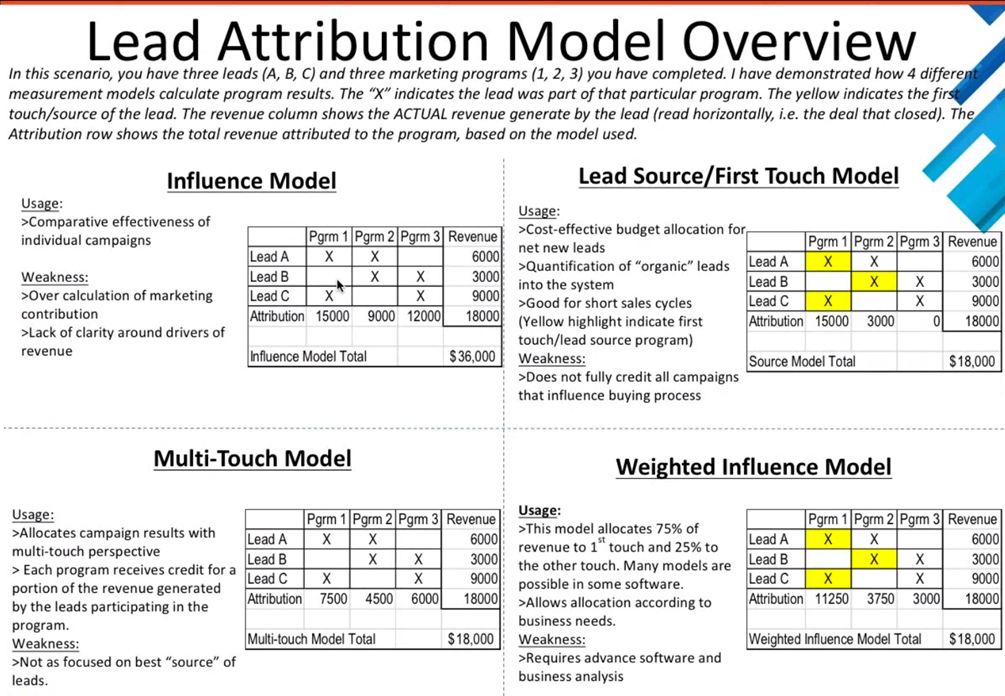Attribution Models
Marketing Cheat Sheet: The Pros & Cons of Attribution Models
“Half the money I spend on advertising is wasted; the trouble is
I don’t know which half.”
– John Wanamaker, US department store merchant (1838 – 1922)
In the data-driven windfall that is marketing today, it’s easy to see why marketers have fallen head over heels for metrics and data analytics.
Without the ability to attribute marketing’s efforts to revenue, marketing is out of step with how other departments are thinking about success. The right attribution model arms marketers like you with the campaign-performance insights you need to optimize your marketing mix… and shows how marketing delivers results!
The question is, which attribution model(s) should you use and what are the differences?
The pros & cons of the major types of lead attribution models
Here’s a look at four types of lead attribution models used to calculate your program results:

These examples all involve the same leads, same programs, and same revenue, but—as you can see—you’ll report very different results for the various programs based on which attribution model you use.
1. Influence Model
PROS: This is the most common model used today. It’s easy to pull this type of report from Salesforce, which is one reason it’s so popular. It can be used to compare the effectiveness of one campaign over another but with some limitations.
CONS: This model isn’t very sophisticated and, consequently, has weaknesses. For example, the only criterion for attribution may be that the lead was, in fact, part of the program (and maybe achieved some level of success in the program, but not always). But worse, since the full pipeline value is attributed to every campaign that the lead participated in, the effectiveness of each campaign is clouded and allows for pipeline revenue to be counted multiple times, depending on how many programs the lead engaged with. But the big problem happens when marketing adds all these programs together and announces how their programs drove pipeline in amounts that are completely different than what sales is tracking. This kind of reporting can really hurt the relationship with sales!
2. Lead Source/First Touch Model/Last Touch Model
PROS: This model shows which programs are most effective in bringing in net new leads. You can basically switch out first touch for last touch if that makes more sense for your business. This model gives 100% of the credit for the pipeline revenue to a single campaign. This makes a lot of sense for businesses that have short sales cycles since the lead is not likely to have been part of lots of a different campaign efforts.
It is also an important view into which lead sources are delivering the best performing net new contacts. If you are using last touch before conversion (either to MQL or opportunity) this can also give you insights into what types of programs are the best at converting contacts into the next stage.
CONS: This model doesn’t credit all of the channels or touches that influence the buying process. So it can be hard to get a clear picture of the results stemming from a particular campaign if it was not likely to be the first (or last touch) for a lead. Often nurturing programs and events are undervalued in these types of models.
3. Multi-touch Model
PROS: I’ve found that this is the best model for accurately understanding campaign effectiveness. It allocates campaign results and revenue evenly across all the campaigns the lead participated in. Therefore, it can more accurately calculate each individual campaign’s contribution to revenue.
CONS: Some users feel the even attribution to programs seems arbitrary. Do you give the same weight to the downloading of an asset from your website as you do to attending a webinar? The standard multi-touch model doesn’t try to discern which activity is more important (and in many ways, we never know). So, while even distribution tries to give visibility into all the programs that might have influenced the lead, it’s not perfect.
4. Weighted Influence Model
PROS: This model allows for allocation according to business needs. It takes the buying cycle into account when determining influence. You can weight certain channels or specific programs as a bigger influence.
CONS: This is more complex and requires more advanced software and business analysis. You are also sometimes required to make some arbitrary decisions about how to weight various marketing campaigns which may or may not reflect the reality of their influence on the buyer’s journey.
I am a big advocate of the third model. It does require a strong marketing technology infrastructure to pull off. However, in a world where prospects digitally interact with your brand an average of 8-12 times before a sale is closed, you can’t afford to not be able to attribute revenue across multiple campaigns and touches. You will have to determine how important this kind of attribution is for your business. It takes some work on the front end to set up the optimal model for your company, but once you start tracking and measuring, you’ll be glad you did!
Which attribution model works best for your business? Please keep me posted on what’s working for you.






Leave a Reply
Want to join the discussion?Feel free to contribute!